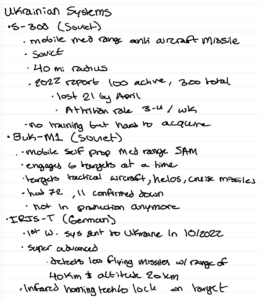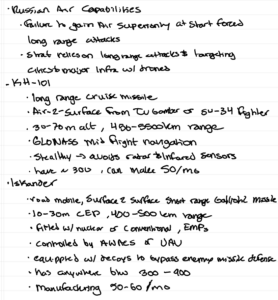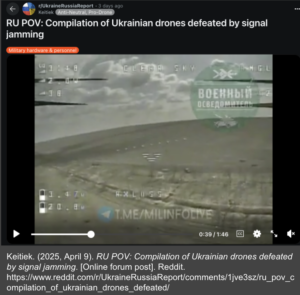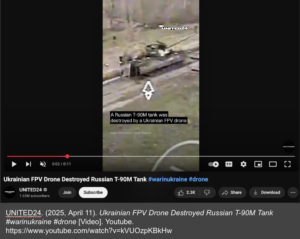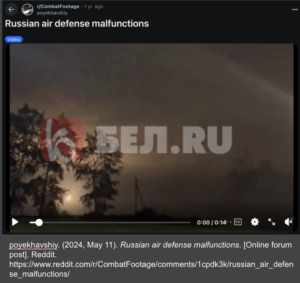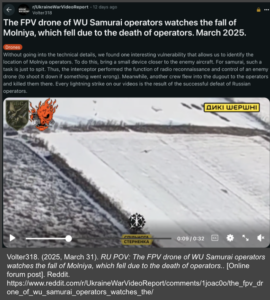Week 5: Target Acquired! Locked! Engaged!
Hey there! Welcome back to week 5 of my senior project – analyzing the role of OSINT in Ukrainian defense! This week, I began my three-week focus on tactical intelligence, starting with the air war. Let’s get into it!
I started this week at Blue Skies of Texas for the AFIO monthly chapter meeting. Before the presentation, I was able to chat with a retired Navy couple who were both intelligence officers and had a combined 50+ years of service. They provided me with valuable insight in planning my future career, including talking to recruiters, learning languages, taking military aptitude tests, and navigating a military career as a female officer. After I talked with them, Mr. Franklin gave the monthly intelligence briefing surrounding the invasion of Ukraine. He first addressed something I’ve been focusing heavily on in the last few weeks – the relevance of social media in warfare. Specifically, he discussed statistics of the “TikTok Attack,” and how more and more American adults receive their news solely from TikTok. This “attack” is threatening as TikTok disseminates large amounts of disinformation compared to more academic news sources.
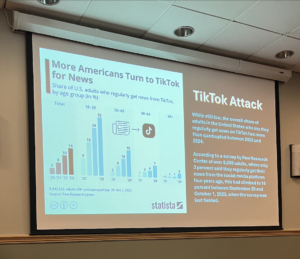
Then, he addressed a recent and effective threat against Ukrainian troops – the deployment of Iranian Shahed 136 kamikaze UAVs (unmanned aerial vehicles) by Russia. He emphasized the tactical capabilities of the Shahed as well as the efficient supply chain of the cheap offensive drones. The Shahed is produced in both Russia and Iran, but recent Ukrainian air strikes have been made on alleged Russian manufacturing facilities.
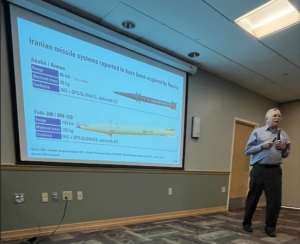
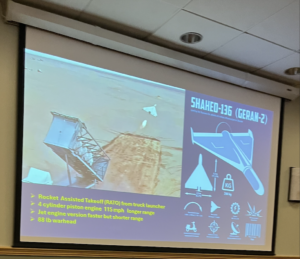
Lastly, he described the current Russian violation of international law as “the fox being put in charge of the chicken house.” After the USSR collapsed, Ukraine possessed the third-largest nuclear arsenal. Because major powers were concerned about the large stockpile in a “new” nation, Ukraine, Russia, the United Kingdom, and the U.S. entered a series of disarmament negotiations from 1991-1994. The most notable of these agreements is the Budapest Memorandum, which guaranteed Ukraine financial support and guaranteed security from Russia, the U.S., and the UK so long as they gave up their nuclear weapons to Russia. As we know, this treaty has since been violated by the Russian invasion, highlighting the alarming possibility of Ukraine obtaining nuclear capabilities because Russia violated their half of the agreement, creating a green light for Ukraine to do the same.
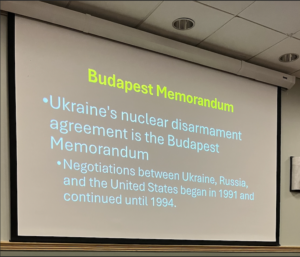
I found Mr. Franklin’s presentation incredibly helpful for my analysis this week. Not only did he set up the historical stage for the missile conflict occurring in Ukraine currently, but he also introduced me to new technology to be aware of, like the Shahed. Also, it was valuable to see how he gave an intelligence briefing and used OSINT to provide a multi-source intelligence solution with images, statistics, and historical stories before my presentation to AFIO in May!
After the meeting, I began my dive into tactical intelligence (TACINT). In the last few weeks, I’ve been conducting strategic intelligence by looking at the larger picture and narrative. TACINT instead focuses on actionable data that can be directly given to troops and be used on the mission level. For example, TACINT would involve giving troops information on a nearby Russian battalion’s personnel count, weapons capabilities, morale, and position.
When researching the role of OSINT in collecting tactical intelligence, I found four key purposes.
- Getting quick, real-time data: Classified intelligence often takes time to process and disseminate from the national focal point to troops on the frontline. OSINT doesn’t process through these complicated, classified channels, meaning a battalion intelligence officer can quickly collect data relevant to their location.
- Extracting locations of activities: Classified intelligence agencies will use wiretapping, satellites, or other sources to discover important events. However, it’s not always clear where these events took place. With OSINT collection, social media data or AI live maps can be used to find these spots. For example, a national agency may know of a Russian battalion in a certain block of a town, but with OSINT, Ukrainian troops can figure out the exact building.
- Creating databases: Because it takes major intelligence agencies time to put together briefs on the latest equipment and casualty data, OSINT collectors maintain databases with this information readily available. These databases are constantly updated, meaning troops can take into account weapons stockpiles, capabilities, and casualties. This week, I made databases on each side’s missile and drone stockpiles, largely from Virginia Tech’s OSINT report from their Tech4Humanity Lab (Tech4Humanity Lab at Virginia Tech, 2023). These databases are useful to execute strategies informed by logistics.
Building My Ukrainian Missile Defense Database Building My Russian Offensive Missile Database - Exploiting opportunities: Often, Russian troops will make social media posts about their experiences in war. By following this social media data, Ukrainian intelligence collectors can analyze troop morale or weapons issues that would make it a good time to strike.
The 14th UAV Regiment is responsible for conducting offensive drone strikes and reconnaissance missions. They have used OSINT by collecting Russian messages on an app called “Telegram,” which is similar to Reddit. By viewing Russian messages, they were able to test the effectiveness of their strikes if the Russians posted on Telegram that drones were loud or easily detectable by anti-air defense systems. Additionally, they could track where Russian battalions were moving their anti-air defense systems to conduct more calculated strikes (Kyiv’s drone units banking on OSINT to fill US intelligence loss, 2025).
Next, I reviewed the basics of the air war in Ukraine. The first major point is that neither side has achieved air superiority. Because each side possesses similar capabilities and effective air defense systems, there’s no decisive victory in the air. Thus, both sides must be cautious with air casualties and focus more on defense and weapons depletion. Secondly, Ukrainian air defense is highly dependent on Western support. Soviet-era technology fails to detect low-altitude UAVs, so Ukraine is dependent on Western technologies like the U.S. Patriot system and the German IRIS-T. Lastly, drone warfare is essential in this conflict. Drones are cost-effective, smaller, quieter, require less training, and protect human resources more than traditional aircraft. Ukraine is reliant on drones coming in from Western countries, China, and even battlefield-manufactured drones. These drones perform offensive strike operations, ISR (intelligence, surveillance, reconnaissance) missions, and contribute to the narrative war through psychological operations. I’ve contextualized my analysis by focusing on these main points of the air war.
After learning the basic uses of tactical OSINT, I began practicing my collection and analysis. I’ll walk you all through a couple of examples, and what I gained from the post. At the end of these three weeks on TACINT, I plan to use these analyses and my databases from above to provide my suggestions for Ukrainian defense strategy. As always, click the image or see the image citation to go directly to the post website. Content Warning: Due to the subject matter, some posts will show violent images not shown on this blog post. Viewer discretion is advised.
- Russian Electronic Warfare on Ukrainian Drones
This post shows a series of videos of Ukrainian FPV (first-person view) UAVs losing connection (AXLOSS) from their Ukrainian operator and reconnecting to a Russian operator at certain coordinates and altitudes. These videos were posted by Russian electronic warfare (EW) specialists on Telegram and discovered by OSINT analysts. As Ukrainian advanced drone technology typically outpaces Soviet-era anti-air defense systems, EW has been the most effective Russian countermeasure to Ukrainian UAVs. Using this OSINT information, Ukrainian UAV operators can change their mission strategy to avoid areas where EW is prevalent, reduce radio power, or employ different counter-jamming signals.Reddit u/Keitiek Post: Ukrainian Drones Downed by Russian EW - New Russian UAV
This image was also retrieved from a Russian source, who posted images of the new UAV. It appears to mimic the Russian Lancet UAV but also appears to have new air-to-air interception technology. These images can be sent to Ukrainian UAV regiments to watch out for these new devices on radar to avoid air-to-air collisions. - Ukrainian UAV Strikes an Abandoned Russian Tank
Footage from a Ukrainian reconnaissance drone shows an offensive UAV decimating a Russian tank. This allows frontline troops to determine the effectiveness of drone strikes but reveals more than that. When the footage zooms in, the tank hatch is left open, hinting that it has been abandoned. The abandonment could mean nearby Russian motorized regiments are changing their strategy or running low on fuel.YouTube Video UNITED24: Ukrainian UAV Destroys Abandoned Russian Tank - Russian Anti-Air Defense System Malfunctions
This footage appears to have been taken by Russian civilians within the Russian borders (most likely around the Kursk region) because of the city-like infrastructure and female voice in the background. It shows an anti-air missile deploying in a strange manner with the female voice asking, “Why does it fly like that?” This information can be transferred to Ukrainian mortar or UAV regiments to conduct a strike while these systems are down.Reddit u/poyekhavshiy Post: Russian Anti-Air Defense System Malfunctions - New Method to Combat the Molniya-2 Drone
Russia’s new Molniya-2 drone has been deemed the AK-47 of UAVs because of its effectiveness and reliability in combat. However, through OSINT analysis, UAV experts can detect new ways to combat the drone. In this case, bringing a small radio device near the drone will allow troops to locate the operator and strike. This information can be disseminated to UAV regiments when they encounter a Molniya-2.Reddit u/Volter318 Post: Ukraine Takes Down Russian Molniya-2 UAV
To sum up this week, I met with Mr. Franklin to discuss things to look for when searching for tactical intelligence. He mentioned two significant sources: photographic reconnaissance and soldier observations. Additionally, we discussed the strange era of war this conflict is occuring in where AI and advanced technology work alongside outdated yet necessary Soviet-era defense systems. Lastly, he pointed me toward DIA and CIA reports I should read to give my briefing on North Korea in May.
That’s it for this week! Thanks for staying locked on target with me!
References:
Kyiv’s drone units banking on OSINT to fill US intelligence loss. (2025, January 4). Intelligence Online. Retrieved April 9, 2025, from https://www.intelligenceonline.com/surveillance–interception/2025/04/01/kyiv-s-drone-units-banking-on-osint-to-fill-us-intelligence-loss,110406715-eve
Tech4Humanity Lab at Virginia Tech. (2023, April 27). Ukraine War OSINT Analysis: A Collaborative Student Report. Virginia Tech Department of Political Science. Retrieved March 31, 2025, from https://tech4humanitylab.clahs.vt.edu/wp-content/uploads/2025/03/UkraineWarOSINTAnalysis-ACollaborativeStudentReport-SM-1.pdf

